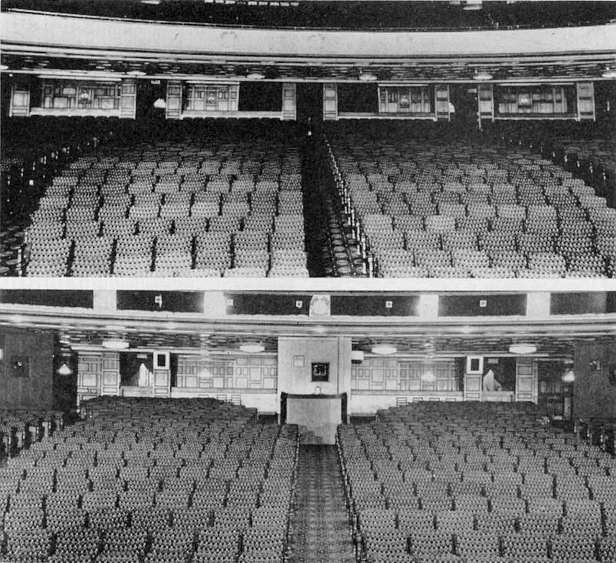from the console, as described later) ; an amplifier for one of the auditorium speakers: a servo-mechanism to keep the projector in synchronization with the other units: an intercommunication unit: and a special fail-safe button. The latter is designed for use only in the event of trouble, and is a safety precaution giving the operator in this booth the means to stop the entire show if necessary.
A single projector serves each of the booths, since Cinerama utilizes a special 8,000-foot reel, giving a 50 minute show. The program plans include an intermission at the end of each reel, and an interval of an hour or more between shows. Thus there is ample time for rewinding and preparing the next reel.
A room must be provided for film inspection. A space about 12x16 feet is adequate for this purpose. and the room should be located close to the three picture booths and on the same level. This film inspection room is equipped with several electric rewinds, and a large hand rewind of sufficient capacity to handle four 8,000-foot reels, and equipped with a four-way synchronizer.
No cabinet for storage is required, as the reels are each individually stored in a special can, approved by the Interstate Commerce Commission for shipment. These large cans are simply stored next to each other in a row, or otherwise, as the working requirements of the staff dictate. This provides full safety, with maximum flexibility in handling the film.
In the original installations, one man has been assigned to operate the inspection room for training purposes. However, the ultimate plan is to have the individual operators perform this function after the initial stage. Thus, each projectionist will be responsible for his own film, with the duties of rewinding it and seeing that it is in proper working condition. This is an important reason for placing the inspection room as close as possible to the projection booths.
The physical condition of the film is of exceptional importance in Cinerama, since the four projectors (including the sound projector) are run synchronously. Any damage of a frame or two cannot be remedied by the familiar procedure of just removing that little section -- instead, it is necessary to splice in a new section, so that all four films remain precisely the same length. Omission of one frame would throw that print out of synchronization.
Three complete sets of prints are furnished for each theatre presenting Cinerama, giving ample standby protection. As the prints become worn, they are used as spares. The availability of the three sets gives the inspection room the opportunity to make the necessary replacement of frames when a film is torn or otherwise damaged.
Directly in front of the central projection booth is the console operator (who has been referred to erroneously as the "mixer"). He sits in an enclosed

Here is what happens to the main floor of an auditorium in a theatre equipped with the three-booth system of Cinerama. The upper photo shows the auditorium as it appeared before the remodeling took place and, as Detroiters knew it for many decades. The lower pictures shows the three booths at the rear and the control panel area directly in front of the center booth. Approximately 50 seats were eliminated to provide the center booth alone.
partitioned area, giving somewhat the appearance of a low judge's bench in a courtroom, overlooking the seats of the patrons. His job is to coordinate the operation of the four projectors to produce the optimum presentation upon the screen and through the sound system. Probably the outstanding special characteristic of Cinerama is its overwhelming illusion of depth in two senses--sight and sound. Here at the console is the control point for making this illusion ultimately effective.
The console operator has a bank of dials and indicators in front of him, which tell the condition of the various machines and make possible the necessary adjustments. One bank of lights is used to indicate for each projector its control position-local or remote-that is, whether it is under the control of the projectionist in the booth or the console operator. Suitable control switches are provided for the latter for all necessary operations.
A separate bank of lights, functioning when the projectors are on, "blink" at predetermined intervals to indicate the movement of the projector. If all four lights blink in unison, the four projectors are in perfect synchronization: however, if there is any difference in the blinking cycle between the different indicators, a correction is necessary.
If the film in one machine is off two or three frames for any reason, it is probable that few in the
audience would immediately notice it, but the console operator, specially trained for this purpose, would catch this condition and take steps to correct it. He has at his fingertips the controls of a special electronic mechanism which serves to crank each of the three picture projectors individually, to either add or subtract frames at will. This correction can be made before the audience is aware of any problem existing.
A complete intercommunication system is used, with the central station of course at the console. The operator here can talk to any position-each of the four projection booths, backstage to the house electrician's switchboard, and to the inspection room. Each of these stations, however, has communication only with the console, so that there is no opportunity for crosschecking and confusion-everything is centralized under the direction of the console man.
Another new procedure brought into the theatre by Cinerama is the controlled variation of light intensity in each of the picture projectors. The console operator has special controls which give him the opportunity to correct variations of intensity between the machines, within a narrow limitation. When it is recalled that in this process the central projector throws to the central portion of the screen, while the two
Continued on following page